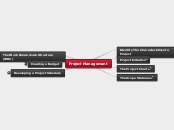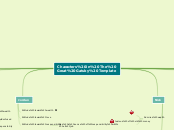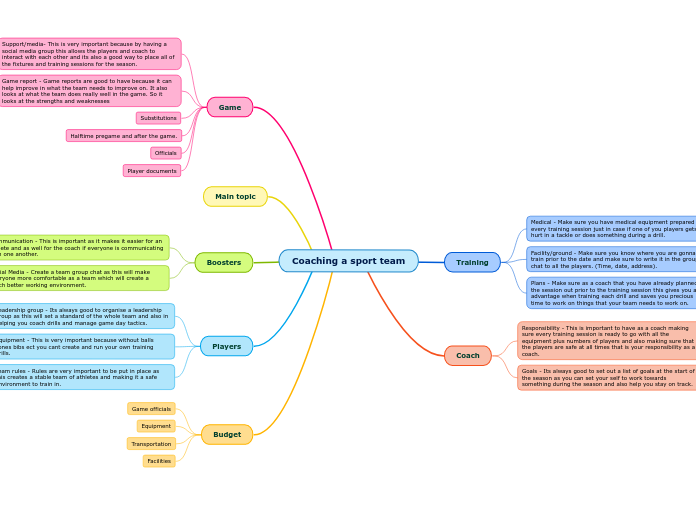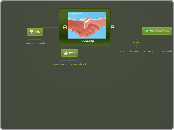Project Managemant
Developing a Project Schedule
Fast Tracking
Doing sequential tasks at the same time, will increase risk.
Crashing
Adding or reallocating resources, will increase cost.
Schedule Compression
Shortening of the schedule.
Resource Leveling
Process used to level unbalanced use of resources (usually people or equipment) over time, and for resolving over-allocations or conflicts.
Late Finish (LF)
The latest a task can finish.
Late Start (LS)
The latest point which a task can begin.
Early Finish (EF)
The earliest a task can finish.
Early Start (ES)
The earliest point a task can begin.
Float
Schedule flexibility.
Critical Path Method (CPM)
Based on dependencies, determines the length of the project.
Arrow Diagram Method (ADM)
Type of network diagram where the activity is represented by an arrow. the length of the arrow indicates the duration of the task.
Network Diagram
Where activity nodes are represented by blocks connected with arrows. Duration information can be included on the nodes.
Precedence Diagram Method (PDM)
Used to determine the order in which activities should be completed.
Gantt Chart
Displays tasks as bars, includes beginning and end dates as well as duration. Also shows dependencies.
Summary Chart
Displays tasks as bars, includes beginning and end dates as well as duration.
Milestone Chart
Shows milestones as diamonds, includes completion dates.
Schedule Compression
Fast tracking
Involves some risk
Perform them partially parallel
Sequential activities
Crashing
May take more time ultimately
Qualifications
Familiarity with task/project
Usually incurs additional costs
Assigning more resources to task
Resource Leveling
Delaying
Could effect the project
Lengthen the scheduled time
Spread out tasks
Avoid over allocation
Optimizing the distribution of work among resources
Less resources over a longer period?
More resources for a shorter time?
Are the resources dedicated or shared?
Less resources at the end
More resources at the beginning
Demand does not exceed availability
Scheduling Methods
Gantt Chart
Depenedencies
Summary Chart
Duration
Begin and end date
Shows activities as bars
Milestone Chart
Gives completion dates
Displays milestones as diamonds
Float Overview
Calculating Float
Backward pass
Late finish (LF) Latest a task can finish
Late start (LS) Latest a task can start
LS = LF - duration + 1
Float: LS - ES or LF - EF
Work backward from end to begining
Forward pass
Early start (ES) Earliest a task can begin
Early finish (EF) Earliest a task can finish
EF = ES + duration - 1
Work from beginning to end
Schedule flexability
Critical Path Method
Monitor closely
Identify the critical path
Any change impacts the endpoint
Determines the project endpoint
Based on dependencies
Graphical Evaluation and Review Technique (GERT)
Forward, backward, sideways
Conditions, branches, loopbacks
Allows for "What if?" analysis
Network analysis tool
Arrow Diagram Method (ADM)
Only finish to start dependency
Arrow length reflects duration
Activity on arrow (AOA)
Dependencies
Start to finish
Task B doesn't finish before task A starts
Finish to finish
Task B doesn't finish before task A is finished
Start to start
Task B doesn't start before task A starts
Finish to start
Task B doesn't start until task A completes
Network Diagram
Activity on node (AON)
Activity nodes
Successors and predecessors
Precedence diagram method (PDM)
Resource Assignments
Re-assign critical resources
Assign resources to tasks
Let software do the work
Let resource availability define the schedule
Asses skills
Outsourcing
Identify training needs
Identify existing resource availibility
Based on resource calender
What We Need to Create a Schedule
Patience
Expect to iterate
Task dependencies
Resource assignments (preferably named)
Task estimates
Why Do We Need a Schedule?
Schedule baseline
Identify schedule conflicts
Coordinate project resources
Coordinate project activities
Integrate with other activities
What Is a Schedule?
Create the critical path
Identify resource requirements
Defines key project dates
Creating a Budget
Cost Management Plan
A document that describes how the organization will manage cost variances on the project.
Management Reserve Fund
Percentage of budget set aside, used at the discretion of senior management.
Contingency/Project Reserve Fund
Percentage of budget set aside to cover unexpected costs.
Function Points
Used to estimate the relative size and complexity of software according to guidelines set forth in the International Function Point Users Group (IFPUG) Counting Manual.
Indirect Costs
Costs that are not directly related to the products or services of the project, but are indirectly related to performing the project.
Direct Costs
Costs that can be directly related to producing the products and services of the project.
Elapsed Time
Calender based according to availability.
Effort Time
Based on actual uninterrupted effort.
PERT Estimate
Average of three estimates where the most likely estimate is weighted four times as much as the other two.
Three Point Estimate
Average of three estimates; best case, worst case, and most likely.
Parametric Modeling
Mathematical formula based on predetermined values.
Analogous or Top-down Estimates
Based on historical data of past similar projects.
Bottom-up Estimates
Starts at the lowest level of the WBS
Elements of the Cost Management Plan
Cost baseline
Project budget
Chart of accounts
Assign costs
Control limits
Cost Management Plan
Planning needed to control costs
Cost output estimates - Amount being recieved
Input costs estimates - Amount being spent
Defines how you will complete the project cost estimating
Contingency
Management reserve fund
Controlled by senior management
Same rules apply
Project reserve fund
Controlled by the project manager
Usually a percentage of total budget
Set aside to cover unexpected costs
Should be included in the project budget
Associated Risks
Dealing with unknowns
Changes to the project scope
Inflation
Changing technology
Fluctuation in pricing
Accuracy
Allocation
Indications of possible overruns
Assess planned vs. actual spending
Carefully planned and monitored
How will the money be spent and when
High cost can affect cash flow
Timing of expenditures
Estimating Recomendations
Combine estimates to create a cost baseline
Software tools
Document estimates and calculations
Brainstorming
Involve your project team
Estimating Techniques
Function point
The International Function Point Users Group (IFPUG) Counting Manual
Based on activities and tasks
Experience of the estimator
Cost Estimates
Indirect Costs
Rent, etc...
Incidentals
Direct costs
Labor
Same methods
Cost of goods and services
Estimating Work Hours
Work with your team members
Vacation
Holidays
Lag time
Off-time
Availability
Calender Based
Elapsed time
Effort time
75% - 80%
Resource availability
Named vs. average resource
Skills
Independent of availability
Based on actual effort - uninterupted
Effort not duration
Realistic estimates
Estimating Types
Parametric modeling
Values
Mathematical
Analogous (top-down)
Less accurate
Quicker - general idea cost
Historical data from previous similar projects
Bottom-up estimates
Bottom-up estimating
Program Evaluation and Review Technique (PERT)
Three Point Estimate
Most likely scenario
Best and worst case scenario
Allowance for change
Start at the lowest level of the work breakdown structure
Reserve amounts
Risk
Production costs
Costs for equipment
Costs for any specialized services
Workload required to complete each phase of the project
Divide your project into phases
Work breakdown structure (WBS)
The Work Breakdown Structure (WBS)
WBS Dictionary
Document generated by the WBS creation. Provides a more detailed description of the components in the WBS.
Guidelines Method
Organizational processes already in place.
Analogous Method
Based on historical data.
Bottom-up Method
Starts with the specific, ends with the general.
Top-down Method
Starts with the general, ends with the specific.
Work Package
A measurable unit of work that can be assigned to one resource; Used for estimating time and cost; Usually not to exceed 80hrs; Not a task list.
Decomposition
Breaking down the project deliverables into smaller more manageable units of work.
WBS Recomendations
WBS is iterative
constantly changing
WBS dictionary
Every item needs to be documented
Buy-in
Everyone has to agree
Responsibility of a single person
WP should be small enough for one person
Outcomes or results, not actions
Mutually exclusive elements
No overlap.
The 100% rule
WBS contains all of the work
THe sum of the work
SHould not contain anything from outside the scope
WBS Chart
(Example)
Subproject 5
Deliverable 5
Deliverable 4
Deliverable 4.1
Work package 4.1.2
Work package 4.1.1
Phase 3
Work package 3.1.4
Work package 3.1.3
Work package 3.1.2
Work package 3.1.1
Deliverable 3.1
Phase 2
Deliverable 2.3
Deliverable 2.3.1
Work package 2.3.1.2
Work package 2.3.1.1
Deliverable 2.2
Work package 2.2.1
Deliverable 2.1
Deliverable
Less than 80 hours
could be project charter
Developing WBS
Create hierarchical outline
Monitor
Decompose those tasks
Scope statement
Major tasks
Identify the major business goals
WBS Methods
Guidelines
Example: Government
Organizational process
Analogous
Example: Manufacturing
Lots of data already exists
Previous similar projects
Bottom-up
for creating a new technology or product
situation with stakeholder who has specific agenda
Specific (start)
General (end)
Top-down
Starts with key deliverables
prefered method
General (Start)
Specific (end)
Importance of the WBS
Necessary for:
Resource planning
Amount of people,time, etc.
Risk management planning
Activity definition
needed to complete deliverables
to determine dependencies
Scheduling
Estimating costs and budgeting
WBS Dictionary
Every element needs to be documennted
Provides more detail
Responsible individual
Contract information
Acceptance critera
Quality requirements
Cost estimates
Resources required
Generated by the WBS process
Supports the WBS
WBS
Not a task list
don't break it down too small
Work package
elements of work
Less than 80 hours
Realistic estimate of time and cost
Assign to a single resource
Smaller, easily managed components
Break down of the deliverables
Decomposition of the scope statement
to create the wb structure
better controll of the
The Scope Statement
Key Performance Indicators (KPI)
Quantifiable measurements, agreed to beforehand, that reflect the critical success factors of the project.
The Scope Statement
A detailed account of the project deliverables. Provides a common understanding of the project scope to the stakeholders.
Product Scope
The features and functions of the product, service, or result.
Project Scope
The work that needs to be accomplished to deliver a product, service, or result with the specified features and functions.
Acceptance and Approval
Stakeholders understand and agree
Clear understanding. All have to agree.
Formal presentation
Clear, concise and convincing.
Involve stakeholders in the process
Make them feel like they have a stake in the process.
Project asumptions
Assumptions before we begin.
Consequences if false
Assumptions made
Project constraints
Restrictions of time, cost and quality
Project boundries
What is going to be done and what is not going to be done
What work will and won't be included
Project deliverables
Need to be clearly identifies. Tied to specific milestones. More specific they are and clearly identifiedthe less chance there will be for scope creep later.
Milestones
Product acceptance critera
Key performance indicators
Product scope description (objectives)
Features and functions that characterize our product,service or result.
Tools and Techniques
Alternatives
Alternative solutions may be another way to do the project
Product analysis
Expert judgement
Subject matter experts
Professional associations
Consultants
Defining Scope
Project scope baseline
Detailed scope
Clearly defined boundaries
Failure to do so will cause problems
Clearly defined (important)
WHat is included and not included
Quantifiable and identified clearly
Define the scope
Objectives that have to be met during the project
The work that needs to be accomplished
Qualitative and/or focus on general statements
Usually a paragraph or two
The Planning Phase
Project Manager does this
Is a living document
Always being reviewed and revised
Stakeholder involvement
Alert when potential problems arise
Analyze risk
Who's doing what and when
Organize the work
Identify the resources needed
Facilities
Equipment
People
How we will meet the business requirements
What is the work
The Project Charter
Consensus
Agreement among the key stakeholders concerning specific project decisions
Statement of Work (SOW)
A narrative description of products or services to be delivered by the project
Project Charter
The result of the initiation planning process. This document provides formal approval for the project to begin and authorizes the project manager to apply resources to the project.
Consensus
Customer Expectations
Written confirmation
Acceptable or unacceptable risk
Availability of resources
Completion date
Anticipated budget
Description of the product
Problem statement
Building Consensus
Achieve consensus and approval
Narrow down to a single decision
Present clearly, concisely, and convincingly
Develop new, mutually advantageous approaches
Define, and often re-define the conflict
Pursue different opinions
Consider all viewpionts
Allow people to voice there concerns/objections
Involve your stakeholders
Lack of consensus
Scope creep
Project timeline and/or budget in peril
Stakeholders working against one another
Necessary between stake holders and project manager
Agreement on scope
Consensus decision
Elements of the Project Charter
High-level assumptions and constraints
High-level risk assesment
High-level budget
High level timeline with major milestones
The project deliverables
The business need
The business case
Project description
The project manager
The project sponsor
The project name
Inputs to the Project Charter
Organizational process assets
Historical data
Templates
Processes
Enterprise environmental factors
Issues that may influence the charter
Contracts
Project for an external customers
Business Case
Cost/benefit analysis
Justification for the project
Statement of work (SOW)
Strategic plan
Business need
Description of products or services
What is the Project Charter?
May vary for different organizations
Names the project manager
Names the sponsor
Defines the business need
Project blueprint
Formal authorization of the project
Project Initiation
Project Team
Carries out the work of the project
Sellers/Vendors
Provide specialized knowledge or services; Contracted to provide these for the project
End-user
Uses the product or service on a daily Basis
Customers
Receives the output of the project
Project Manager
Manages the project; Responsible for seeing the project through to a successful conclusion
Project Sponsor
Initiates the work, champion of the project
Stakeholders
People who care about, or are affected by the project
Business Need
The reason for the project request
The Stakeholders
Who cares about the project?
Getting Vendors Involved
Statement of Work (SOW)
What the vendor will deliver
Request for Proposal (RFP)
What the project requires
When Requirements Collide
Present to the stakeholders
Long-term goals
Devise alternate solutions
Rank in order of importance
List and evaluate requirements
Assumptions About the Project
Retain for the future discussion and review
Sign-off
Collect and organize
Stakeholder Requirements
Clear and precise
Politics and personalities
Their definition of success
How they feel about the project
Needs and expectations
Stakeholder Matrix
How much influence and involvement does each stakeholder have?
Involvement
High
Influence
None
Little
Some
Great
Key Stakeholders
Project Team
Specialized knowledge
Specific skill sets
Carry out the work
Sellers/vendors
Provide services or components for the project
Business partners
Directly uses the product or service
Internal or external
Group or an organization
Receives the output of the project
Accurate and timely reporting
Identify and monitor risk
Keeps the project on track
Developes the project management plan
Manages the project
Project Sponsor
Decision Maker
Champion of the project
Provides the resources
Initiates the work
Identify the Stakeholders
Examples
Direct team members
Media
End-user
Customer
General Public
Subject matter expert
Sponsor
Seller/vendor
Involvement on the project
What kind of influence?
Who might have influence over our project?
Who will be affected by the project?
Stakeholders
Not all stakeholders will support the project
Internal and external
Appropriate communication
Expectations need to be met
Have influence over the project
May be involved during different phases of the project
Have something to gain to lose
Someone impacted in the project
Someone who is actively involved in the project
Validate the Project
Do we need this project?
Measuring Success
Is it attainable?
Can we reasonably expect success?
Can they be measured?
Qualitative
Quantitave
Do they mean something?
Address the business need
Goals and objectives should be clear and attainable
Requirements
Historical Data
Timing
Functional requirements
Technical requirements
What do we need?
Gather Information
Beware of misinformation
Define the business requirements
What do the stakeholders need?
The Business Case
Will it help us in the future?
Is it really necessary?
Does it add value to the business?
Does the project align to our strategic plan?
Who, What, Why
The Business Need
Problem must be clearly defined
Research?
Decrease in spending?
Increase revenue?
Market or industry driven?
Regulatory or legal requirements?
Why do we need this?
What do they want?
How do you define success?
What is the final result?
What are the goals?
What is the project?
Information
Product
Service
Identify the Project
Who is requesting this?
Business analysts
Internal or external customers
Receive the Project request
Identify The Characteristics of a Project
Key Terms
Triple Constraint
The constraints of the scope, time and cost, that the project is bound by.
The Project Life Cycle
Executation
Monitoring/control
Project Management Process Groups
Organizational Structures
Projectized
Full control of the budget
High to almost total resource availability
High to almost total authority
Dedicated full time to the project
Team Members have no department
Matrix
Stromg Martix (PM)
Full control of budget
Moderate to high resource availability
Moderate to high authority
Weak Matrix (PM)
No control of the budget
Limited resource ability
Limited authority
Part-time
Balanced Matrix (PM)
Mixed control of budget
Low to moderate resources availability
Low to moderate authority
Full-time
Team members report to their manager and the project manager
Blend of Functional & Projectized
Functional
Project manager
No control over the budget
Little or no control/authority
Resources often part-time
Silos of Work
Report only to their manager
Staff organized by department
IT Project Management
Simultaneous linked projects - program
Design and implementation
Intangible, e.g. application development
Iterative
Any project that is related to IT
Automated systems
Server/system Improvements
Datacenter creation/improvements
Infrastructure updates
Software Development
Project Management Knowledge Areas
Quality Management
Integration Management
Procurement Management
Risk Management
Communications Management
Human Resource Management
Cost Management
Time Management
Scope Management
Resources
A Guide to the Project Management Body of Knowlwdge (PMBOK Guide)
Project Management Institute (PMI)
Project Manager
Attention to Detail
Trust
Problem Solving
Support
People skills
Communication
Budgeting
Negotiation
Leadership
Organized
Project Process
Closure
Phase output: formal acceptance and sign-off
Create a final report
Review project
Close contracts
Release resources
Closure of the project
Turn over deliverables
Monitoring & Controlling
Phase output: take corrective action
Execute approved changes
Analyze the issues associated with the deviations
Continuously monitor the project
Execution
Phase output: deliverables finished and accepted
Coordinate staff
Execute the plan
The real work begins
Planning
Phase output: the project management plan
Identify resources
Identify the risks
Define the budget
Develop the schedule
Initiation
Phase output: the project charter
Ascertain the duration and resources
Identify the deliverables
Define scope
Name the project and project manager
Define and authorize the project
Recognizes the beginning of the project
Triple Constraints
Scope
What must be done to produce the project's end result
Cost
The budgeted amount available for the project
Time
The amount of time available to complete a project
Project vs. Operations
Operations or Processes
Repetitive
Ongoing effort
Project
Must have clearly defined and measurable goals
Always Temporary
Meets specific business need
What is a project?
New
Creates a unique product or service
Has a beginning and end
A temporary endeavor









